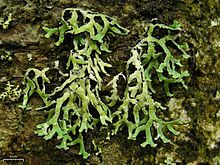| Anzia | |
|---|---|

| |
| Anzia colpodes | |
| Scientific classification | |
| Domain: | Eukaryota |
| Kingdom: | Fungi |
| Division: | Ascomycota |
| Class: | Lecanoromycetes |
| Order: | Lecanorales |
| Family: | Parmeliaceae |
| Genus: | Anzia Stizenb. (1861) |
| Type species | |
| Anzia colpodes (Ach.) Stizenb. (1862) | |
| Synonyms | |
| |
Anzia is a genus of foliose lichens known as black-foam lichens in the large family Parmeliaceae. It was formerly included in the monogeneric family Anziaceae, but this has since been subsumed into the Parmeliaceae.
Taxonomy
The genus name of Anzia is in honour of Martino Anzi (1812-1883), an Italian botanist and professor of theology from Como.
The genus was circumscribed by Ernst Stizenberger in 1862, with Anzia colpodes assigned as the type species. This lichen was originally described as Lichen colpodes by Erik Acharius in 1799.
In 1932, Yasuhiko Asahina divided the genus into three sections (Simplices, Duplices, and Nervosae) based on the structure of the medulla. When Isao Yoshimura later observed that Anzia japonica had two medulla types in a single species (i.e. both a single-layered and a double-layered medulla), he combined sections Simplices and Duplices into section Anziae.
Description
Members of Anzia have a foliose growth form, with a thallus that can measure anywhere from 2–30 cm (0.8–11.8 in) wide. The narrow lobes that comprise the thallus are pale greyish white to greyish green in colour. It is one of the only groups in the family not to have eight spores in each ascus, but instead has numerous spores in each ascus (varying slightly from ascus to ascus). These ascospores are crescent shaped. A characteristic of the genus is the presence of a brown-black or pale brown spongy cushion called a spongiostratum, which covers the lower surface.
Pannoparmelia also has a spongiostratum, but in this genus the asci contain eight ascospores, and the upper cortex is yellow-green.
Distribution
The genus has a cosmopolitan distribution, but is concentrated in the Northern Hemisphere, particularly in Japan.
Evolutionary history
A fossilized Anzia, Anzia electra, was found in 35–40 Myr-old Baltic amber. Its features suggest that the main distinguishing characteristics in the thallus morphology of section Anzia have been retained for tens of millions of years.
Species


- Anzia centrifuga Haugan (1992) – Porto Santo, Madeira
- Anzia colpodes (sack black-foam lichen) (Ach.) Stizenb. (1862)
- Anzia electra† Rikkinen & Poinar (2002)
- Anzia entingiana Elix (1997) – New Zealand
- Anzia flavotenuis Jayalal, Wolseley & Aptroot (2012) – Sri Lanka
- Anzia formosana Asahina (1937)
- Anzia gallowayi Elix (2007) – Australia
- Anzia hypoleucoides Müll.Arg. (1891)
- Anzia hypomelaena (Zahlbr.) Xin Y.Wang & Li S.Wang (2015) – China
- Anzia isidiosa Yoshim. (1995) – New Guinea
- Anzia japonica (Tuck.) Müll.Arg. (1889) – China; Japan
- Anzia leucobatoides (Nyl.) Zahlbr. (1907) – China
- Anzia mahaeliyensis Jayalal, Wolseley & Aptroot (2012) – Sri Lanka
- Anzia minor Yoshim. (1992)
- Anzia opuntiella Müll.Arg. (1881) – Asia
- Anzia ornata (Zahlbr.) Asahina (1937) – Asia; North America
- Anzia pseudocolpota Xin Y.Wang & Li S.Wang (2015) – China
- Anzia rhabdorhiza Li S.Wang & M.M.Liang (2012) – China
- Anzia tianjarana Yoshim. & Elix (1992) – Australia
References
- "Synonymy: Anzia Stizenb". Species Fungorum. Retrieved 11 December 2020.
- Crespo, A.; Lumbsch, H. T.; Mattsson, J. E.; Blanco, O.; Divakar, P. K.; Articus, K.; Wiklund, E.; Bawingan, P. A.; Wedin, M. (2007). "Testing morphology-based hypotheses of phylogenetic relationships in Parmeliaceae (Ascomycota) using three ribosomal markers and the nuclear RPB1 gene". Molecular Phylogenetics and Evolution. 44 (2): 812–824. doi:10.1016/j.ympev.2006.11.029. PMID 17276700.
- Burkhardt, Lotte (2022). Eine Enzyklopädie zu eponymischen Pflanzennamen [Encyclopedia of eponymic plant names] (pdf) (in German). Berlin: Botanic Garden and Botanical Museum, Freie Universität Berlin. doi:10.3372/epolist2022. ISBN 978-3-946292-41-8. S2CID 246307410. Retrieved January 27, 2022.
- Stizenberger, E. (1861). "Anzia, eine neue Flechtengattung". Flora (Regensburg) (in German). 44: 390–393.
- Acharius, E. (1799). Lichenographiae Sueciae Prodromus (in Latin). Linköping: D.G. Björn. p. 124.
- Asahina, Y. (1935). "Anzia-Arten aus Japan". Journal of Japanese Botany. 11: 224–238.
- Yoshimura, I. (1987). "Taxonomy and speciation of Anzia and Pannoparmelia". Bibliotheca Lichenologica. 25: 185–195.
- ^ Wang, Xin Yu; Goffinet, Bernard; Liu, Dong; Liang, Meng Meng; Shi, Hai Xia; Zhang, Yan Yun; Zhang, Jun; Wang, Li Song (2015). "Taxonomic study of the genus Anzia (Lecanorales, lichenized Ascomycota) from Hengduan Mountains, China". The Lichenologist. 47 (2): 99–115. doi:10.1017/S0024282914000644. S2CID 87916877.
- Galloway, D.J. (2007). Flora of New Zealand - Lichens - Revised 2nd Edition http://floraseries.landcareresearch.co.nz/pages/index.aspx
- Rikkinen, Jouko; Poinar, George O. (2002). "Fossilised Anzia (Lecanorales, lichen-forming Ascomycota) from European Tertiary amber". Mycological Research. 106 (8): 984–990. doi:10.1017/S0953756202005907.
- Haugan, Reidar (1992). "Anzia centrifuga, a new lichen species from Porto Santo, Madeira". Mycotaxon. 44 (1): 45–50.
- "Standardized Common Names for Wild Species in Canada". National General Status Working Group. 2020.
- ^ Jayalal, Udeni; Wolseley, Pat; Gueidan, Cécile; Aptroot, André; Wijesundara, Siril; Karunaratne, Veranja (2012). "Anzia mahaeliyensis and Anzia flavotenuis, two new lichen species from Sri Lanka". The Lichenologist. 44 (3): 381–389. doi:10.1017/S0024282911000946. S2CID 86955461.
- Elix, John A. (2007). "New species in the lichen family Parmeliaceae (Ascomycota) from Australasia". Bibliotheca Lichenologica. 95: 171–182.
- Yoshimura, I.; Sipman, H.J.M.; Aptroot, A. (1995). "The lichen genus Anzia in New Guinea". Bibliotheca Lichenologica. 58: 439–469.
- Liang, Meng Meng; Qian, Zi Gang; Wang, Xin Yu; Chen, Hong Mei; Liu, Dong; Wang, Li Song (2012). "Contributions to the lichen flora of the Hengduan Mountains, China (5). Anzia rhabdorhiza (Parmeliaceae), a new species". The Bryologist. 115 (3): 382–387. doi:10.1639/0007-2745-115.3.382. JSTOR 23321053. S2CID 85660113.
- Yoshimura, I.; Elix, J.A. (1993). "The lichen genera Anzia and Pannoparmelia in Australia". Journal of the Hattori Botanical Laboratory. 74: 287–298.
| Taxon identifiers | |
|---|---|
| Anzia | |